Computers:
The Computer is an electronic device which performs multiple operations by processing the information. For example, addition, subtraction or any other arithmetic operations. Today’s computers have the power to performs the millions of operations in seconds and gives accurate results. The computers play the main role in a man’s life by solving the problems in seconds. How did it all happen? Where did it start? The development of computers divided into many generations. So, you need to know about the generations of computers and when it was started and its features.
By increasing the new technologies, computers are becoming cheaper, smaller which increases the buying of users. In the early 80’s, it is impossible to find the home who had the computer. This scenario has changed dramatically to the point that the impossible to find the computer without a home that performs tasks.
Generations of Computers:
The Generations of computers are classified based on its operations and devices used in it. Also, consider the architectures, language, technology and modes of operation. Well, the generation of computers uses different devices and languages by changing the time. Later the time has passed we saw the many latest technology improvements in hardware and software. In each generation of computer, the new advancements are evolved. Lets us begin with the first generations of computers.
Generations of Computers and its Time Periods:
- First Generation of computers (1946- 1959)
- Second Generation of computers (1959-1965)
- Third Generation of computers (1965-1972)
- Fourth Generation of computers ( 1972-1980)
- Fifth Generation of computers(1982- Present)
First Generation of Computers:
The first generation of computer is introduced in 1946. Whereas, the first generation used vacuum tubes as the CPU and magnetic drum for storing the data. The size of the computer in this generation is larger like room size and limited to basic operation.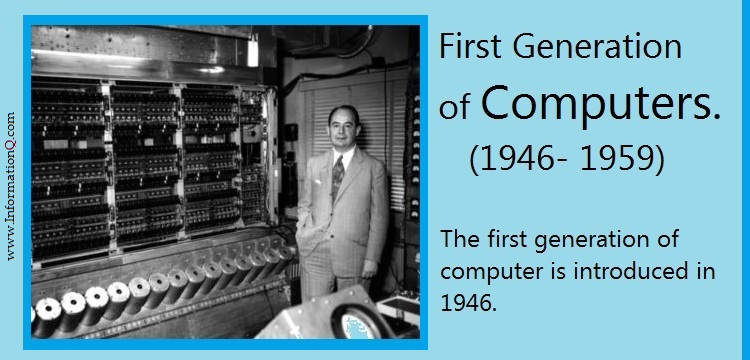
It uses the machine language to take the input knows as 1GL or first generation language. Moreover, the first generation computer uses the punch cards, magnetic tape, paper tape for entering the input, and storing output and data. Examples of first generation computer are ENIAC, UNIVAC, EDSAC, and EDVAC.
Second Generation of Computers:
The Second Generation of Computer uses the transistor in the place of vacuum tubes. The transistor was developed in Bell Labs in 1947, but introduced in computers 1950’s. Whereas, it is more reliable, faster, cheaper and smaller in size than the first generation of computers. Well, it uses the high-level of computer languages by taking the input such as COBOL, FORTRAN, etc.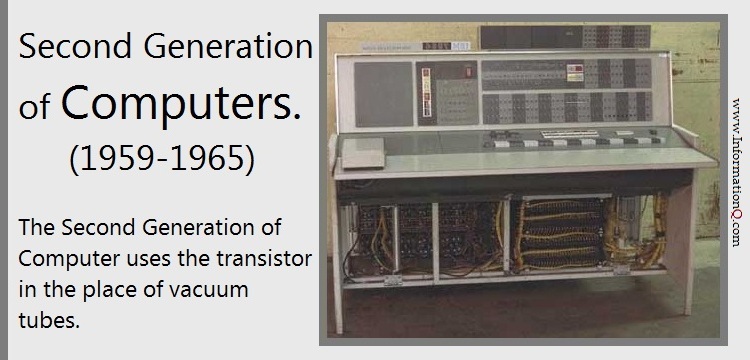


The second generation computers use the magnetic tape and magnetic core as the primary storage, and the secondary storage uses the magnetic disks. The Example of this generation computer is IBM 1620, IBM 7094, CDC 1604, CDC 3600, UNIVAC 1108. In this generation of computers, the storage capacity and the use of computer users increased.
Third Generation of Computers:
The second generation of computers uses the transistors in the place of vacuum tubes. But, the transistor produces the big amount of heat which damages sensitive parts in the computers. To eliminate this problem, the Third Generation of Computer introduced in 1965. Whereas, these computers differ from first and generation of computers and it uses the IC (Integrated Circut). The IC is the small circuit which contains the thousands of transistors, resistors to make the computer. By inventing the IC’s in the third generation, it became possible to fit thousands of elements in a small area to create the computer. Additionally, it reduces the size of the computer in a small size.
Moreover, the third generation computers use the COBOL, FORTRAN-II to FORTRAN-IV, PASCAL, ALGOL-68, BASIC by taking the input. By using these languages, it can perform the complex operations and produce accurate results. The third generation of computers is the IBM-360 series, PDP (Personal Data Processor), Honeywell-6000 series, and IBM-370/168.
Fourth Generation of Computers:
The Fourth Generation of Computers are comes with VLSI (Very Large Scale Technology) also we can call it as microprocessors. Whereas, the Intel was the first company to introduce the microprocessor and firstly, design the PC or personal computer in this generation by IBM. Well, the VLSI circuits include 500 transistors on the single chip which performs the high-level of operations and computations.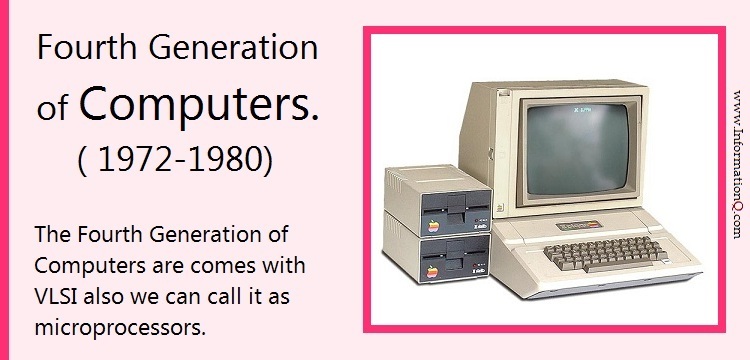


These generation computers require the limited power to run. This generation of computers allows users to use the computer for word processing, spreadsheets, file managing and graphics. The computer languages like C, C++, and DBase are used in this generation to perform the accurate operations. The concept of networking and CD-ROM came into existence in the fourth generation. Examples of this generation computer are STAR 1000, CRAY-X-MP (Super Computer), PDP 11, DEC 10, and CRAY-1.
Fifth Generation of Computers:
Now we use the Fifth Generation of Computers which were started around 1982. These computers differ from the previous four generations. Well, these generation computers use the high level of languages like Perl, Python, C, JAVA, etc. Moreover, the Ultra Large Scale Integration technology was introduced in 5th generation computers which leads to the development of a microprocessor chip with several millions of chips on it.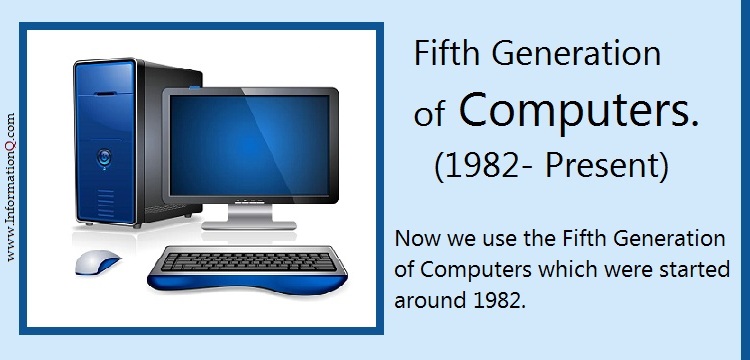


It introduces the laptops, notebooks, PC’s, desktops, and many more during this period. Besides, these computers are based on Artificial Intelligence. Well, the fifth generation computers perform the parallel processing which fast results. In this generation of the computers, the new languages are introduced like object-oriented languages like C++, JAVA, etc. The new operating systems are developed MS Window, Linux and Linux based components are developed. Example of fifth generation computers are Notebook, Laptop, Desktop, Ultra book, Chrome book, and many more.
Advantages of Fifth Generation of Computers:
- The fifth generation of the computer is much faster than four generation of computers.
- Whereas, these computers smaller and give fast results as compared with other generation computers.
- Moreover, these computers are portable so that, you can carry the devices anywhere and access at any time. Easy to handle these portable devices.
- With this generation computers, you can perform the multiple operations at a time with no slow down.
- The new version technologies are improved to repair the problems of computers.
- The fifth generation computers introduce an improvement in semiconductor technology and Artificial Intelligence.
Sixth Generation of Computers:
The Sixth Generation of computers is different from, other generation computers in terms of size, speed and tasks that perform. These computers are called intelligent computers based on artificial intelligence or artificial brains. Whereas, it uses the semiconductors as the raw material to its processors. Moreover, the sixth generation introduces the voice recognization which takes dictation and recognizes the words. By using the voice recognization, you can search and send the messages quickly and easily. Although people need to speak slowly and clearly to work properly. With the 6th generation computers, the complex problem solving is possible and researches are ongoing to find the ways to solve the problems more efficiently and easily.



In the military, the AI helped soldiers for unexpected problems arises in many situations around the world. Additionally, it helps to prevent the many of world’s spy network problems, and also it can determine the actions occurring high volatile parts of the world. In the automobile technology, robots are used for manufacturing, but the artificial intelligence is used in some cars which allow to breaking and wearing the vehicle if necessary.
Future Generation Computers:
In Today’s Computer, we touch everything virtually. But, the future computers may be neurons and attains the human level intelligence. We all have the image that the computer is a rectangular box either on desk or packet. We can think that computers are in cars or refrigerators. Whereas, you can operate the refrigerator with your phone or communicate with a light bulb. In fact, in the coming years, your light bulb became the computer which performs operations and projects the information instead of light. Similarly, biological computing performs the operations using DNA or RNA and understand the biotechnology as one computer.
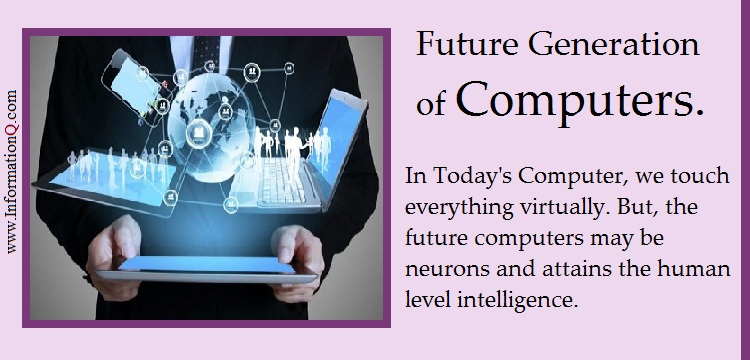


However, the communication between the user and future computer in many ways. We can think that access your computer with voice recognization. The machine can predict before you ask what do you want with emotion sensing. The emotion-sensing technology can help to change the things. We already use the gestures to control the computers. But with image recognization technology to recognize the body motions even when you not in front of the computer screen. In the coming future, the computers may have the pre-touch, brain interface. Nowadays computers operate by using power, semiconductors and metals but, the future computers might use the atoms, DNA and light to perform the tasks.
Conclusion:
Now we have used five generations of computers. In future generation computers have the power to access things like the human brain by taking inputs in different ways. The future generation of computers performs the tasks very faster than previous generations and devices may be invisible or smaller in size.
Related Articles:
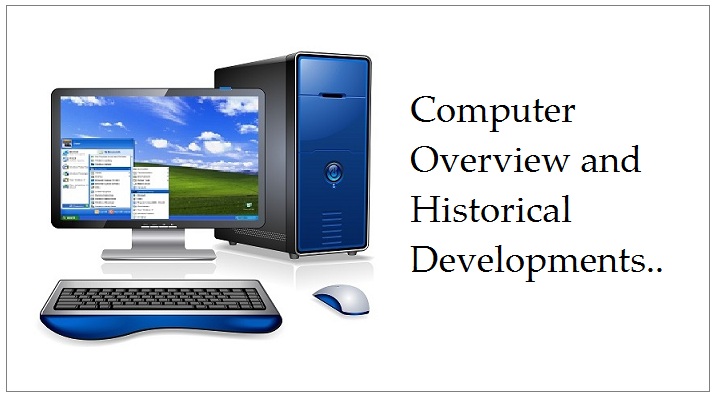   |
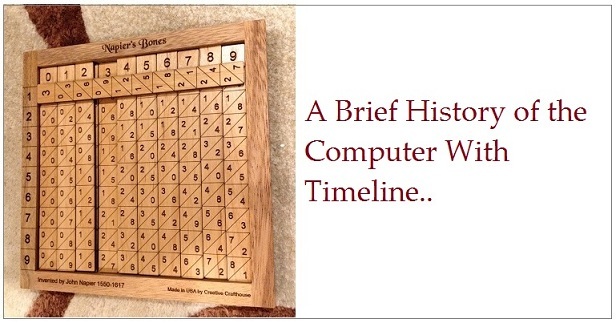   |
   |
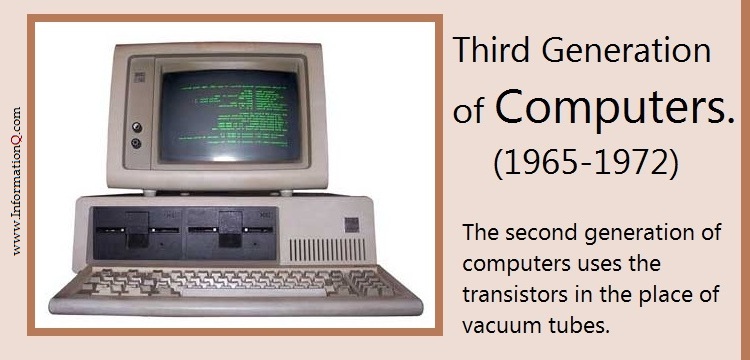
good information